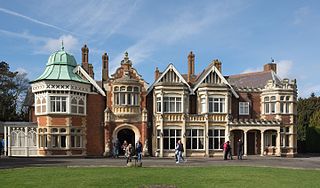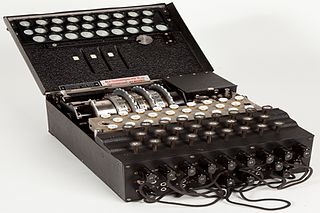Related Research Articles

Bletchley Park is an English country house and estate in Bletchley, Milton Keynes (Buckinghamshire) that became the principal centre of Allied code-breaking during the Second World War. The mansion was constructed during the years following 1883 for the financier and politician Sir Herbert Leon in the Victorian Gothic, Tudor, and Dutch Baroque styles, on the site of older buildings of the same name.

Cryptanalysis refers to the process of analyzing information systems in order to understand hidden aspects of the systems. Cryptanalysis is used to breach cryptographic security systems and gain access to the contents of encrypted messages, even if the cryptographic key is unknown.

The Enigma machine is a cipher device developed and used in the early- to mid-20th century to protect commercial, diplomatic, and military communication. It was employed extensively by Nazi Germany during World War II, in all branches of the German military. The Enigma machine was considered so secure that it was used to encipher the most top-secret messages.

Ultra was the designation adopted by British military intelligence in June 1941 for wartime signals intelligence obtained by breaking high-level encrypted enemy radio and teleprinter communications at the Government Code and Cypher School (GC&CS) at Bletchley Park. Ultra eventually became the standard designation among the western Allies for all such intelligence. The name arose because the intelligence obtained was considered more important than that designated by the highest British security classification then used and so was regarded as being Ultra Secret. Several other cryptonyms had been used for such intelligence.

Fish was the UK's GC&CS Bletchley Park codename for any of several German teleprinter stream ciphers used during World War II. Enciphered teleprinter traffic was used between German High Command and Army Group commanders in the field, so its intelligence value (Ultra) was of the highest strategic value to the Allies. This traffic normally passed over landlines, but as German forces extended their geographic reach beyond western Europe, they had to resort to wireless transmission.
Magic was an Allied cryptanalysis project during World War II. It involved the United States Army's Signals Intelligence Service (SIS) and the United States Navy's Communication Special Unit.

The bombe was an electro-mechanical device used by British cryptologists to help decipher German Enigma-machine-encrypted secret messages during World War II. The US Navy and US Army later produced their own machines to the same functional specification, albeit engineered differently both from each other and from Polish and British bombes.

Room 40, also known as 40 O.B., was the cryptanalysis section of the British Admiralty during the First World War.

In cryptology, a code is a method used to encrypt a message that operates at the level of meaning; that is, words or phrases are converted into something else. A code might transform "change" into "CVGDK" or "cocktail lounge". The U.S. National Security Agency defined a code as "A substitution cryptosystem in which the plaintext elements are primarily words, phrases, or sentences, and the code equivalents typically consist of letters or digits in otherwise meaningless combinations of identical length." A codebook is needed to encrypt, and decrypt the phrases or words.
Cryptanalysis of the Enigma ciphering system enabled the western Allies in World War II to read substantial amounts of Morse-coded radio communications of the Axis powers that had been enciphered using Enigma machines. This yielded military intelligence which, along with that from other decrypted Axis radio and teleprinter transmissions, was given the codename Ultra.
Cryptography was used extensively during World War II because of the importance of radio communication and the ease of radio interception. The nations involved fielded a plethora of code and cipher systems, many of the latter using rotor machines. As a result, the theoretical and practical aspects of cryptanalysis, or codebreaking, were much advanced.
Various conspiracy theories allege that U.S. government officials had advance knowledge of Japan's December 7, 1941, attack on Pearl Harbor. Ever since the Japanese attack, there has been debate as to why and how the United States had been caught off guard, and how much and when American officials knew of Japanese plans for an attack. In September 1944, John T. Flynn, a co-founder of the non-interventionist America First Committee, launched a Pearl Harbor counter-narrative when he published a 46-page booklet entitled The Truth about Pearl Harbor, arguing that Roosevelt and his inner circle had been plotting to provoke the Japanese into an attack on the U.S. and thus provide a reason to enter the war since January 1941.

Hut 8 was a section in the Government Code and Cypher School (GC&CS) at Bletchley Park tasked with solving German naval (Kriegsmarine) Enigma messages. The section was led initially by Alan Turing. He was succeeded in November 1942 by his deputy, Hugh Alexander. Patrick Mahon succeeded Alexander in September 1944.
Before the development of radar and other electronics techniques, signals intelligence (SIGINT) and communications intelligence (COMINT) were essentially synonymous. Sir Francis Walsingham ran a postal interception bureau with some cryptanalytic capability during the reign of Elizabeth I, but the technology was only slightly less advanced than men with shotguns, during World War I, who jammed pigeon post communications and intercepted the messages carried.
Hut 7 was a wartime section of the Government Code and Cypher School (GC&CS) at Bletchley Park tasked with the solution of Japanese naval codes such as JN4, JN11, JN40, and JN-25. The hut was headed by Hugh Foss who reported to Frank Birch, the head of Bletchley's Naval section.
The cipher system that the Uesugi are said to have used is a simple substitution usually known as a Polybius square or "checkerboard." The i-ro-ha alphabet contains forty-eight letters, so a seven-by-seven square is used, with one of the cells left blank. The rows and columns are labeled with a number or a letter. In the table below, the numbers start in the top left, as does the i-ro-ha alphabet. In practice these could start in any corner.

In the history of cryptography, 91-shiki ōbun injiki or Angōki Taipu-A, codenamed Red by the United States, was a diplomatic cryptographic machine used by the Japanese Foreign Office before and during World War II. A relatively simple device, it was quickly broken by western cryptographers. The Red cipher was succeeded by the Type B "Purple" machine which used some of the same principles. Parallel usage of the two systems assisted in the breaking of the Purple system.

The Far East Combined Bureau, an outstation of the British Government Code and Cypher School, was set up in Hong Kong in March 1935, to monitor Japanese, and also Chinese and Russian (Soviet) intelligence and radio traffic. Later it moved to Singapore, Colombo (Ceylon), Kilindini (Kenya), then returned to Colombo.
The Short Weather Cipher, also known as the weather short signal book, was a cipher, presented as a codebook, that was used by the radio telegraphists aboard U-boats of the German Navy (Kriegsmarine) during World War II. It was used to condense weather reports into a short 7-letter message, which was enciphered by using the naval Enigma and transmitted by radiomen to intercept stations on shore, where it was deciphered by Enigma and the 7-letter weather report was reconstructed.
Japanese army and diplomatic codes. This article is on Japanese army and diplomatic ciphers and codes used up to and during World War II, to supplement the article on Japanese naval codes. The diplomatic codes were significant militarily, particularly those from diplomats in Germany.
References
- 1 2 Greg Goebel. "US Codebreakers In The Shadow Of War". 2018.
- ↑ Sterling, Christopher H. (2007). Military Communications: From Ancient Times to the 21st Century. ABC-CLIO. pp. 126–127. ISBN 978-1-85109-732-6 . Retrieved 1 May 2009.
- ↑ "Red Code". Archived from the original on 8 May 2009. Retrieved 1 May 2009.
- ↑ Budiansky 2000, p. 5.
- ↑ "Bletchley Park Jewels Japanese Cryptographic Machines". mkheritage.co.uk.
- ↑ Smith 2000, p. 125.
- ↑ "Early Japanese Systems". NSA Center for Cryptologic History.
- ↑ Smith 2000, p. 93.
- ↑ Mundy, Liza (2017). Code Girls. Hachette Books. ISBN 978-0-316-35253-6.
- 1 2 Hanson, Victor Davis (18 December 2007). Carnage and Culture: Landmark Battles in the Rise to Western Power. Knopf Doubleday Publishing Group. ISBN 978-0-307-42518-8.
- ↑ Budiansky 2000, p. 7–12.
- 1 2 Wilford 2002, p. 18.
- ↑ Dufty 2017, p. 122,123.
- ↑ Dufty 2017, p. 14,64.
- ↑ Dufty 2017, p. 96.
- ↑ Wilford 2002, p. 20: citing Kahn, The Codebreakers.
- ↑ Twomey, Steve (2016). Countdown to Pearl Harbor: The Twelve Days to the Attack. New York: Simon & Schuster. p. 152. ISBN 978-1-4767-7646-0.
- ↑ Wilford 2002, p. 19.
- ↑ Kahn 1996, p. 566.
- ↑ Wilford 2002, pp. 19 & 29.
- ↑ Kahn 1996, pp. 99, 564, 567.
- ↑ Blair, Silent Victory, passim
- ↑ Farago, Ladislas. The Broken Seal (New York: Bantam, 1968), pp.393–395.
- 1 2 "Obituary: Brian Townend". The Times . London. 2 March 2005. Retrieved 1 May 2009.
- ↑ Smith 2000, p. 150.
- ↑ Smith 2000, pp. 191.
- ↑ Smith 2000, p. 153.
- ↑ Smith 2001, pp. 140–143.
- ↑ Gabriel Schoenfeld (March 2006). "Has the 'New York Times' Violated the Espionage Act?". Commentary Magazine. Archived from the original on 18 January 2012. Retrieved 4 October 2017.
- ↑ Smith 2000, pp. 142, 143.